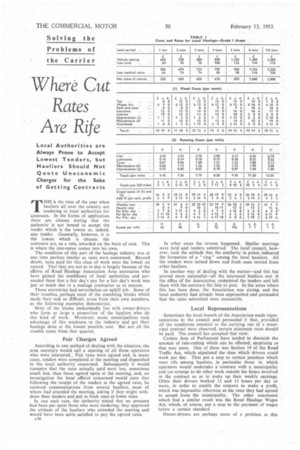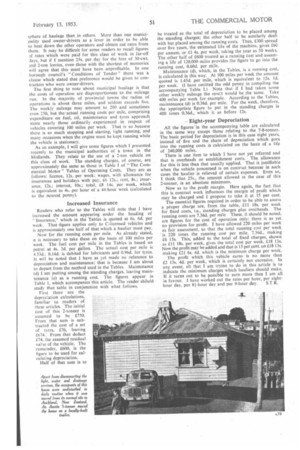Where Cut Rates
Page 54

Page 57

If you've noticed an error in this article please click here to report it so we can fix it.
Are Rife
Local Authorities are Always Prone to Accept Lowest Tenders, but Hauliers Should Not Quote Uneconomic Charges for the Sake of Getting Contracts
Tifis is the time of the year when hauliers all over the country are tendering to local authorities for contracts. In the forms of application there are clauses stating that the authority is not bound to accept the tender which is the lowest or, indeed, any tender. Generally, however, it is
the lowest which is chosen: the contracts are, as a rule, 'awarded on the basis of cost. This is where the rate-cutter comes into his own.
The condition of this part of the haulage industry was at one time parlous insofar as rates were concerned. Beyond -doubt, rates paid for this class of work were the lowest on record, That they are not so to-day is largely because of the efforts of Road Haulage Association Area secretaries who have gained the confidence of local authorities and persuaded them that a fair day's pay for a fair day's work was just as much due to a haulage contractor as to anyone.
Those secretaries bad nevertheless an uphill job. Some of their troubles, perhaps most of the stumbling blocks which made their task so difficult, arose from their own members, as the following examples demonstrate.
Most of the blame undoubtedly lies with owner-drivers who form so large a proportion of the hauliers who do this kind of work. Moreover, many municipalities took advantage of this weakness in the industry and got their haulage done at the lowest possible cost. But not all the trouble came from that quarter.
Fair Charges Agreed According to one method of dealing with the situation, the area secretary would call a meeting of all those operators who were interested., Fair rates were agreed and, in many cases, tenders were completed at the meeting and dispatched to the local authority concerned. Subsequently it would transpire that the rates actually paid were less, sometimes much less, than those agreed upon at the meeting, and, on investigation the local official concerned would state that following the receipt of the tenders at the agreed rates, he received communications from several hauliers, most of whom had attended the meeting, asking if they might withdraw their tenders and put in fresh ones at lower rates.
In one such case, the authority stated that no pressure had been put upon those who were tendering; they approved the attitude of the hauliers who attended the meeting and would have been quite satisfied to pay the agreed rates.
*16 In other cases the reverse happened. Similar meetings were held and tenders submitted, The local council, however, took the attitude that the similarity in prices indicated the formation of a "ring" among the local hauliers. All the tenders were turned down and fresh ones invited from other hauliers.
In another way of dealing with the matter-and this has proved more successful-all the interested hauliers met in the office of the Association, corhpleted the tenders and left them with the secretary for him to post. In the areas where this has been done, the Association WU strong, and the local authority had already been approached and persuaded that the rates submitted were reasonable.
Local Representations Sometimes the local branch of the Association made representations to the council and persuaded it that, provided all the conditions essential to the carrying out of a municipal contract were observed, certain minimum rates should be paid. The council has accepted that view.
Certain Acts of Parliament have tended to diminish the amount of rate-cutting which can be effected, surprising as that may seem. One of these was Section 19 of the Road Traffic Act, which stipulated the time which drivers could work per 'day. That put a stop to certain practices which were rife among hauliers, in particular those in which operators would undertake a contract with a municipality and yet arrange to do other work outside the hours involved in the contract so as to make up their weekly earnings. Often their drivers worked 12 and 13 hours per day or more, in order to enable the concern to make a profit, which was impossible otherwise at the rates they had agreed to accept from the municipality. The other enactment which had a similar result was the Road Haulage Wages Act, which, of course. put a stop to the payment of wages below a certain standard
Owner-drivers are perhaps more of a problem in this
sphere of haulage than in others. More than one municipality used owner-drivers as a lever in order to be able to beat down the other operators and obtain cut rates from them. It may be difficult for some readers to recall figures 3f rates which were paid for this class of work in far-off lays, hut if I mention 25s. per day for the hire of 30-cwt. and 2-ton lorries, even those with the shortest of memories will agree that this must have been unprofitable. In one borough council's "Conditions of Tender" there was a clause which stated that preference would be given to contractors who were owner-drivers.
The first thing.to note about municipal haulage is that the costs of operation are disproportionate to the mileage run. In the majority of provincial towns the radius of operations is about three miles, and seldom exceeds five. The weekly mileage may amount to 200 and sometimes even 250, but the-actual running costs per mile, comprising expenditure on fuel, oil, maintenance and tyres approach more nearly those ordinarily experienced in respect of vehicles covering 100 miles per week. That is so because there is so much stopping and starting, light running, and many occasions when the engine must be kept running while the vehicle is stationary.
As an example, I will give some figures which I presented recently to the municipal authorities of a town in the Midlands. They relate to the use of a 2-ton vehicle on this class of work, The standing charges, of course, are approximately the same as those in Table I of "The Commercial Motor" Tables of Operating Costs. They are as follows: licence, 12s. per week; wages, with allowance for insurances and holidays with pay, £6 12s.; rent, 8s.; insurance, 12s.; interest, 10s.; total, £8 14s. per week, which is equivalent to 4s. per hour of a 44-hour week (calculated to the nearest penny).
Increased Insurance
Readers who refer to the Tables will note that I have increased the amount appearing under the heading of " Insurance," which in the Tables is quoted at 6s. 6d. per week. That 'figure applies only to C-licensed vehicles and is approximately one half of that which a haulier must pay, Now for the running costs per mile. As already stated, it is necessary to take these on the basis of 100 miles per week. The fuel cost per mile in the Tables is based on petrol at 4s. 2d. per gallon. The actual cost per mile is 4.53d.: 0.14d. is debited for lubricants and 0.96d. for tyres. It will be noted that I have as yet made no reference to depreciation and maintenance; that is because I am about to depart from the method used in the Tables. Maintenance (d) I am putting among the standing charges, leaving maintenance (e) as a running cost. The figures appear in Table 1, which accompanies this article. The reader should study that table in conjunction with what follows.
First there are the depreciation calculations, familiar to readers of these articles. The initial cost of this 2-tonner is assumed to be £750. From that sum is subtracted the cost of a set of tyres. £76, leaving £674. From that deduct £74, the assumed residual valae of the vehicle. The remainder. £600, is the figure to be used for calculating depreciation.
Half of that sum is to be treated as the total of depreciation to be placed among the standing charges; the other half to be similarly dealt with but placed among the running costs. Thus, £300 spread over five years, the estimated life of the machine, gives £60 per annum, or £1 4s. per week, taking the year as 50 weeks. The other half of £600 treated as a running cost and assuming a life of 120,000 miles provides the figure to go into the running cost, 0.60d. per mile, Maintenance (d), which, in the Tables, is a running cost, is calculated in this way. At 100 miles per week the amount quoted is I.45d. per mile, which is equivalent to 12s. Id. per week. (1 have omitted the odd penny in compiling the accompanying Table I.) Note that if I had taken some other weekly mileage the result would be the same. Take 400 miles per week for example. According to the Tables, maintenance (d) is 0.36d. per mile. For the week, therefore, the appropriate figure to put in the standing charges is 400 times 0.36d., which is as before 12s.
Eight-year Depreciation
All the figures' in the accompanying table are calculated in the same way except those relating to the 7-8-tonner. The basic period for depreciation is in this case eight years, instead of five and the share of depreciation which goes into the running costs is calculated on the basis of a life of 240,000 miles.
There is one item to which I have not yet referred and that is overheads or establishment costs. The allowance for this is less than that usually applied. That is justifiable when the vehicle concerned is on continct because in such cases the haulier is relieved of certain expenses. Even so, think that 25s., the amount allowed in the case of this 2-tormer, is an absolute minimum.
Now as to the profit margin. Here again, the fact that this is contract work influences the margin of profit which may be charged and I propose to take it at 15 per cent.
The essential figures required in order to be able to assess a proper charge are, from the table, £11 18s. per week for fixed costs, i.e., standing charges plus overheads. The running costs are 7.36d. per mile These, it should be noted, are figures for the cost of operation only: there is as yet no provision for profit. I have allowed 220 miles per week as fair assessment, so that the total running cost per week
• is 220 times the running cost per mile, 7.36d., making £6 15s. This, added to the total of fixed charges, shown as £11 I8s. per week, gives the total cost per week, £18 13s, Now the profit may be added and that is 15 per cent. on £18 13s. making £21 6s. 4d. which is the minimum charge per week.
The profit which this vehicle earns is no more than £2 13s, 4d. per week, which is certainly not excessive. In any event, all that I am tryine to do in this article is to indicate the minimum charges which hauliers should make. If it turns out to be poisible to earn more then I am all in favour. I have worked out the rates per hour, per eight
hour day, per 81-hour day and per 9-hour day. S.T.R.




















































































